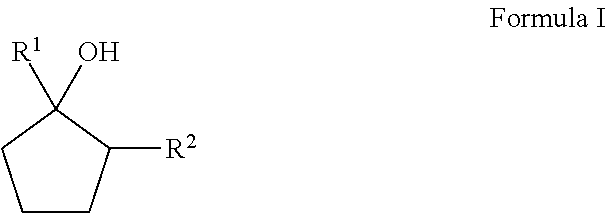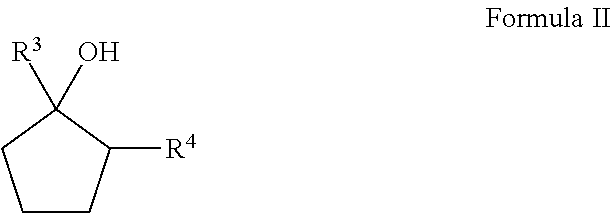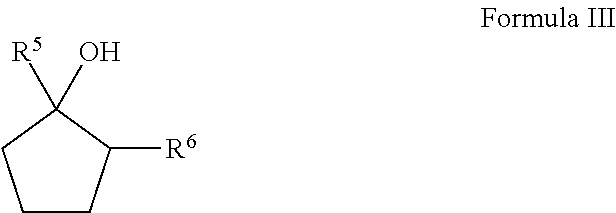Novel cyclopentanol compounds
a technology of cyclopentanol and compounds, applied in the field of new chemical entities, can solve the problems of difficult identification of desirable fragrance chemicals, difficult for those with skill in the art to predict the effectiveness of a given structure, etc., and achieve the effect of improving, enhancing or modifying a fragrance formulation
- Summary
- Abstract
- Description
- Claims
- Application Information
AI Technical Summary
Benefits of technology
Problems solved by technology
Method used
Image
Examples
example i
[0037]
Preparation of 2-Pentyl-cyclopentanone
[0038]A 3-L reaction flask was charged with cyclopentanone (500 g, 6 mol), water (H2O) (500 mL) and sodium hydroxide (NaOH) (10 g, 0.25 mol). Valeraldehyde (430 g, 5 mol) was fed into the reaction flask over 3 hours while the temperature was maintained at 25-30° C. After the feeding was completed, the reaction was aged for 2 hours and neutralized with hydrochloric acid (HCl) (30 g, 0.3 mol) while the temperature was maintained at 25-30° C. The reaction mass was further aged for 2 hours. The organic layer was separated and washed with saturated aqueous sodium bicarbonate (NaHCO3) (200 mL). The obtained crude product was fractionated to provide 2-pentylidene-cyclopentanone (523 g) having a boiling point of 122° C. at 3 mmHg A 1-L zipper autoclave was charged with 2-pentylidine cyclopentanone (523 g) and palladium on carbon (Pd / C) (2 g). The autoclave was purged three times with nitrogen followed by three times with hydrogen. The autoclave ag...
example ii
[0041]
Preparation of 1-Methyl-2-pentyl-cyclopentanol (Structure 63)
[0042]A 3-L reaction flask was charged with methylmagnesium chloride (MeMgCl) solution in tetrahydrofuran (THF) (800 mL, 2.4 mol) and THF (500 mL). The reaction flask was cooled to 5-10° C. 2-Pentyl-cyclopentanone (370 g, 2.4 mol) (prepared as above in EXAMPLE I) was fed into the reaction mixture over an hour. The reaction was aged for 4 hours and then neutralized with acetic acid (CH3COOH) (160 g) while the temperature was maintained at 5-10° C. The reaction mixture was poured into H2O (3 L) and toluene (1 L). The organic layer was separated and fractional distilled to afford 1-methyl-2-pentyl-cyclopentanol (245 g) having a boiling point of 150-152° C. at 3 mmHg
[0043]1H NMR (500 MHz, CDCl3): 1.85-1.91 ppm (m, 1H), 1.62-1.76 ppm (m, 3H), 1.17-1.59 ppm (m, 10H), 1.27 ppm (s, 3H), 1.10-1.20 ppm (m, 2H), 0.89 ppm (t, 3H, J=6.85 Hz)
example iii
[0044]Following cyclopentanols were similarly prepared.
1-Ethyl-2-isobutyl-cyclopentanol (Structure 4)
[0045](boiling point of 145-150° C. at 5 mmHg)
[0046]1H NMR (500 MHz, CDCl3): 1.82-1.90 ppm (m, 1H), 1.62-1.81 ppm (m, 4H), 1.48-1.61 ppm (m, 3H), 1.34-1.47 ppm (m, 2H), 1.12-1.25 ppm (m, 2H), 1.04 ppm (s, 1H), 0.94 ppm (t, 3H, J=7.65 Hz), 0.93 ppm (d, 3H, J=6.60 Hz), 0.86 ppm (d, 3H, J=6.55 Hz)
1-Ethyl-2-pentyl-cyclopentanol (Structure 6)
[0047](boiling point of 165-166° C. at 3 mmHg)
[0048]1H NMR (500 MHz, CDCl3): 1.84-1.90 ppm (m, 1H), 1.60-1.78 ppm (m, 4H), 1.35-1.58 ppm (m, 6H), 1.15-1.35 ppm (m, 6H), 1.13 ppm (s, 1H), 0.94 ppm (t, 3H, J=7.5 Hz), 0.89 ppm (t, 3H, J=6.7 Hz)
1-Ethyl-2-(3-methyl-butyl)-cyclopentanol (Structure 7)
[0049](boiling point of 155-159° C. at 5 mmHg)
[0050]1H NMR (500 MHz, CDCl3): 1.84-1.90 ppm (m, 1H), 1.66-1.81 ppm (m, 2H), 1.64 ppm (t, 2H, J=7.45 Hz), 1.45-1.59 ppm (m, 2H), 1.35-1.45 ppm (m, 4H), 1.18-1.28 ppm (m, 1H), 1.12-1.18 ppm (m, 2H), 1.05 ppm (s, 1H), ...
PUM
| Property | Measurement | Unit |
|---|---|---|
| weight percent | aaaaa | aaaaa |
| weight percent | aaaaa | aaaaa |
| weight percent | aaaaa | aaaaa |
Abstract
Description
Claims
Application Information
 Login to View More
Login to View More - R&D
- Intellectual Property
- Life Sciences
- Materials
- Tech Scout
- Unparalleled Data Quality
- Higher Quality Content
- 60% Fewer Hallucinations
Browse by: Latest US Patents, China's latest patents, Technical Efficacy Thesaurus, Application Domain, Technology Topic, Popular Technical Reports.
© 2025 PatSnap. All rights reserved.Legal|Privacy policy|Modern Slavery Act Transparency Statement|Sitemap|About US| Contact US: help@patsnap.com



